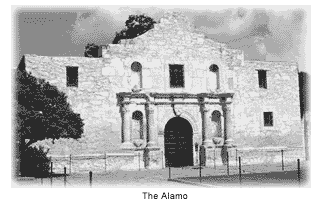Mission San Antonio de Valero was established in its present location by members of the Franciscan Order in 1724. It served the San Antonio area native population until 1793, when religious activities were discontinued and the surrounding lands were distributed to the Indians.
In the early 19th century, part of the old mission complex was used as the headquarters of a Spanish cavalry unit. During this time, the Spanish word alamo, meaning "cottonwood," was introduced by soldiers garrisoned there to honor their home at Alamo de Parras in the Mexican province of Coahuila.
 The larger region of Tejas (Texas) was the scene of mounting tensions during the late 1820s and early 1830s, as increasing numbers of United States citizens flooded across the border into the prime cotton lands west of the Sabine River. Mexico, independent from Spain since 1821, resisted the growing foreign presence, but a full-scale rebellion erupted in the fall of 1835, at the town of Gonzales.
The larger region of Tejas (Texas) was the scene of mounting tensions during the late 1820s and early 1830s, as increasing numbers of United States citizens flooded across the border into the prime cotton lands west of the Sabine River. Mexico, independent from Spain since 1821, resisted the growing foreign presence, but a full-scale rebellion erupted in the fall of 1835, at the town of Gonzales.
In December, Benjamin Milam led a combined force of Tejanos, Spanish-speaking native residents of Tejas, and Texans, English-speaking residents, against a Mexican military unit in San Antonio. The fighting was extremely bitter. Each block and building was contested. In the end, the Mexican commander, General Marín Perfecto de Cós, was forced to surrender and Milam’s soldiers occupied the former mission site at the Alamo.
Over the next two months, the occupying forces worked to strengthen the Alamo's defenses, but were surprised on February 23, 1836 to see the 2,000-man army of General Antonio López de Santa Anna looming on the horizon. At this time, only 155 soldiers manned the garrison.
Commander William Barrett Travis decided to hold out until reinforcements could be brought in. Several scouts managed to slip though the Mexican siege line to carry word of the Alamo defenders' plight to other Texas communities. The response to the plea for help was tepid. The Texas independence movement was badly fragmented because of personal rivalries and widespread confusion. By March 1, only 32 volunteers had been sent by the neighboring community of Gonzales.
Santa Anna’s forces had immediately encircled the Alamo and begun to reduce its walls by artillery fire. Conditions within the old mission deteriorated rapidly. Food and ammunition ran low. At sunrise on March 6, Mexican soldiers began an assault on the structure's walls.
Initially the Texans resisted successfully, but the overwhelming Mexican army eventually managed to get some of its soldiers over the walls and into the fort. The battle turned into a rout when the Mexicans captured the Alamo’s sole cannon and turned its fire on the defenders.
The last-ditch Texan strongholds — a church and barracks — were destroyed and hand-to-hand fighting ensued. By the end of the day, 187 Texan insurgents were dead and only a few civilians were spared to carry word of the great Mexican victory to the outside world. Included among the dead were Travis and such notables as James Bowie and Davy Crockett.
This event, which nearly coincided with the Goliad Massacre, helped to galvanize the Texas Independence movement. Formerly divided leaders now joined in a common cause, realizing that only united action would achieve their end. Six weeks later — under the cry of “Remember the Alamo” — Texan forces won a stunning and decisive victory at San Jacinto.